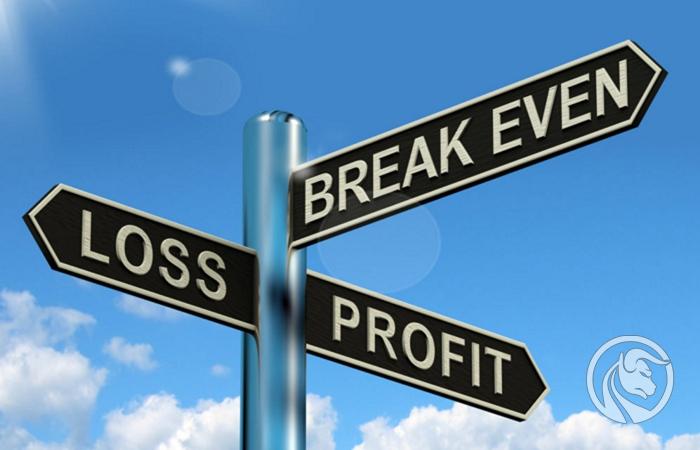Breakeven or not breakeven?
Breakeven or breakeven point (BE or BEP) in trading is determined by the place where the transaction should not bring any risk to the trader and thus any losses.
Breakeven is usually referred to as the place where the transaction takes place on the spot market, where the stop loss order will be moved to secure the existing profit from the previously concluded market position.
So the condition for BE or BEP is first to conclude a trade, then the trade must start generating profit (otherwise it will not be possible to switch the SL order to breakeven), and then, when the profit appears (everyone has to answer the question of how big - whether 5 pips or 55 pips, etc.), the stop loss order is moved to the place of entry into the transaction.
Who needs Breakeven for?
 The main reason is to reduce the pressure on the trader, who knows that he has so-called free position, because she can not bring a loss (unless the weekend gap or other slip). Then the trader feels more comfortable, stresslessly approaching the chart.
The main reason is to reduce the pressure on the trader, who knows that he has so-called free position, because she can not bring a loss (unless the weekend gap or other slip). Then the trader feels more comfortable, stresslessly approaching the chart.
Then there are two options: the first is a closed deal. Then, whether the SL would be switched to BE or not, the goal would be achieved anyway, so the trader collects the profit and it doesn't matter if he changes defensive order or not. The second option is to close the breakeven trade, not the SL. Then the trader breathes a sigh of relief, because instead of a loss, the situation is as if the trade has never been concluded (the result is zero). However, here the topic is not so obvious, because there is one more option for the development of the situation.
READ NECESSARY: Stop Loss. Whether and how to move? [Beginnings on the Forex market]
However, in addition to the two obvious situations, there is a third option, in which the market retreats after the SL order on BE and then continues the take profit move, without going down to the original stop loss order established by shifting to BE. This changes the form of things, because then BE does not save from SL, but takes away the possibility of reaching TP (the market would never go back to the initial SL and go to TP, so the transaction ends at zero, taking profit, not saving the loss).
In order not to be groundless as part of the RNŻ Portfolio, transactions were carried out, under which only one was closed on BE and if not, then there would be a loss on SL.
On the other hand, four transactions were closed on BE (the market first heavily left and then moved back to BE), and then the market continued its march to TP. That is the only breakeven point he saved by loss, and he took profit four times, which ultimately severely spoils the final statistic.
BE cuts losses… and profits
The conclusion is that each stick has two ends. If you use BE, you must be aware that such a shift of the defense order may result not so much in reducing the loss, but in reducing the profit. In this case, potentially profitable transactions end in zero, and transactions where the market immediately turned back to the minus.
It is worth remembering this when considering the legitimacy of using the method of moving the defensive order to the place where the transaction took place.






















![Forex Club – Tax 9 – Settle tax on a foreign broker [Download the Application] Forex Club - Tax 9](https://forexclub.pl/wp-content/uploads/2024/02/Forex-Club-Podatek-9-184x120.jpg?v=1709046278)
![Trading View platform – solutions tailored to the needs of traders [Review] trading view review](https://forexclub.pl/wp-content/uploads/2024/03/trading-view-recenzja-184x120.jpg?v=1709558918)
![How to connect your FP Markets account to the Trading View platform [Guide] fp markets trading view](https://forexclub.pl/wp-content/uploads/2024/02/fp-markets-trading-view-184x120.jpg?v=1708677291)
![How to invest in ChatGPT and AI? Stocks and ETFs [Guide] how to invest in chatgpt and artificial intelligence](https://forexclub.pl/wp-content/uploads/2023/02/jak-inwestowac-w-chatgpt-i-sztuczna-inteligencje-184x120.jpg?v=1676364263)






![Izabela Górecka – “Success on the market depends not only on knowledge, but also on emotional stability” [Interview] Izabela Górecka - interview](https://forexclub.pl/wp-content/uploads/2024/04/Izabela-Gorecka-wywiad-184x120.jpg?v=1713870578)
![WeWork – the anatomy of the collapse of a company valued at $47 billion [WeWork, part II] wework bankruptcy story](https://forexclub.pl/wp-content/uploads/2024/04/wework-bankructwo-historia-184x120.jpg?v=1711729561)
![Adam Neumann – the man who screwed up Softbank [WeWork, part AND] adam neumann wework](https://forexclub.pl/wp-content/uploads/2024/04/adam-neumann-wework-184x120.jpg?v=1711728724)


![The most common mistakes of a beginner trader - Mr Yogi [VIDEO] Scalping - The most common mistakes of a beginner trader - VIDEO](https://forexclub.pl/wp-content/uploads/2024/03/Scalping-Najczestsze-bledy-poczatkujacego-tradera-VIDEO-184x120.jpg?v=1711601376)
![Learning patience: No position is also a position - Mr Yogi [VIDEO] Scalping - Learning patience - No position is also a position - VIDEO](https://forexclub.pl/wp-content/uploads/2024/03/Scalping-Nauka-cierpliwosci-Brak-pozycji-to-tez-pozycja-VIDEO-184x120.jpg?v=1710999249)
![When to exit a position and how to minimize losses - Mr Yogi [VIDEO] Scalping - When to exit a position and how to minimize losses - VIDEO](https://forexclub.pl/wp-content/uploads/2024/03/Scalping-Kiedy-wyjsc-z-pozycji-i-jak-minimalizowac-straty-VIDEO-184x120.jpg?v=1710336731)





![Building a risk management plan - How to do it? [Guide] risk management](https://forexclub.pl/wp-content/uploads/2021/12/zarzadzanie-ryzykiem-300x200.jpg?v=1639495023)
![Automatic Stop Loss on MetaTrader 5 - how to do it? [Video] auto-stop-loss-mt](https://forexclub.pl/wp-content/uploads/2021/11/auto-stop-loss-mt-300x200.jpg?v=1637831541)












definitely breakeven. I often bet on BE and the fact that time can be traced to the possibility of achieving TP, but in general I prefer to leave 5 times 0 and from time to time not pass TP than pass 5x SL and 1-2 more TP.